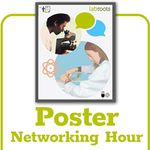AI Analysis of Super-Resolution Microscopy: Novel Insight Into Subcellular Structure
Super-resolution microscopy, or nanoscopy, enables the use of fluorescent-based molecular localization tools to study molecular structure at the nanoscale level in the intact cell. Analysis of super-resolution data by artificial intelligence (AI), or machine learning, offers tremendous potential for discovery of new biology, that, by definition, is not known and lacks ground truth. Application of weakly supervised paradigms to super-resolution microscopy has the potential to enable the accelerated exploration of the nanoscale architecture of subcellular macromolecules and organelles.
Single molecule localization microscopy (SMLM) approaches are based on analysis of stochastic blinking of isolated fluorophores and generate an event list of localizations, or a point cloud, essentially a network of connections between localizations or nodes. Application of a computational pipeline, SuperResNET, to SMLM point cloud data for the coat protein of caveolae, caveolin-1, identified not only caveolae but also three non-caveolar scaffold domains, including the smallest corresponding to the 11-mer caveolin-1 8S complex as well as 8S complex dimers and larger hemispherical S2 scaffold domains.
MCS-DETECT detects contact sites between organelles, separated by sub-pixel distances of 10-60 nm, from stimulated emission depletion (STED) microscopy volumes. MCS-DETECT uses Laplacian detection of local intensity changes to identify regions in 3D STED super-resolution images where the intensity of ER and mitochondria change in tandem. We tuned MCS-DETECT using a group label comparison of HT-1080 cells, expressing ribosome-studded mitochondria-ER contacts (riboMERCs) and COS-7 cells that do not express riboMERCs. riboMERCs present complex tubular shapes intercalating between multiple mitochondria whose formation is dependent on the riboMERC tether protein RRBP1 and size modulated by the Gp78 E3 ubiquitin ligase.
Learning Objectives:
1. Explain the principles of super-resolution microscopy (nanoscopy) and its use in studying subcellular structures at the nanoscale level within intact cells.
2. Analyze the application of artificial intelligence (AI) and machine learning in processing super-resolution microscopy data, specifically focusing on the SuperResNET computational pipeline and its role in identifying nanoscale structures such as caveolin-1 domains.
3. Evaluate the MCS-DETECT tool for detecting organelle contact sites from super-resolution images, and understand its application in distinguishing ribosome-studded mitochondria-ER contacts (riboMERCs) based on sub-pixel intensity variations.




